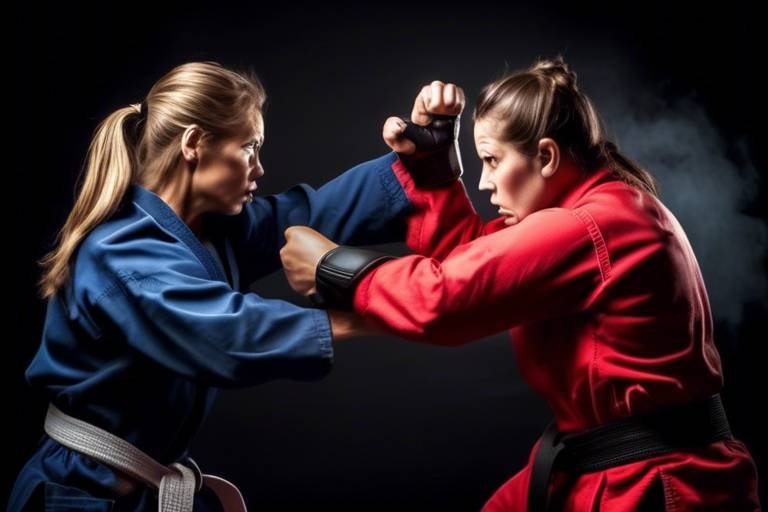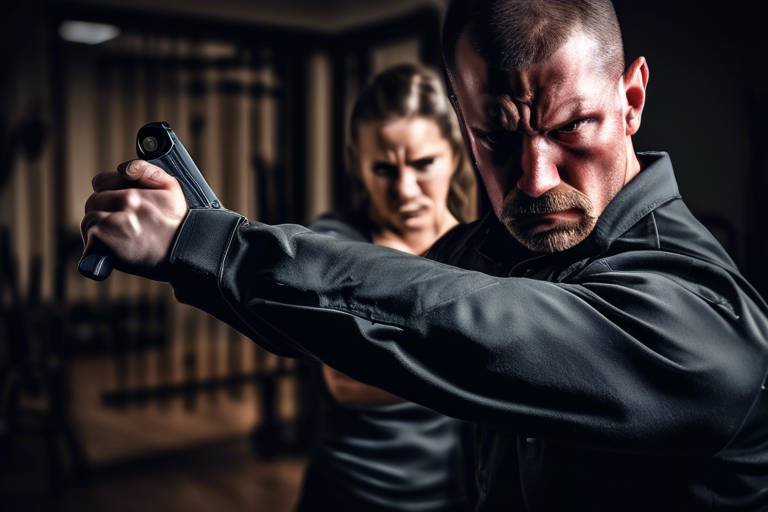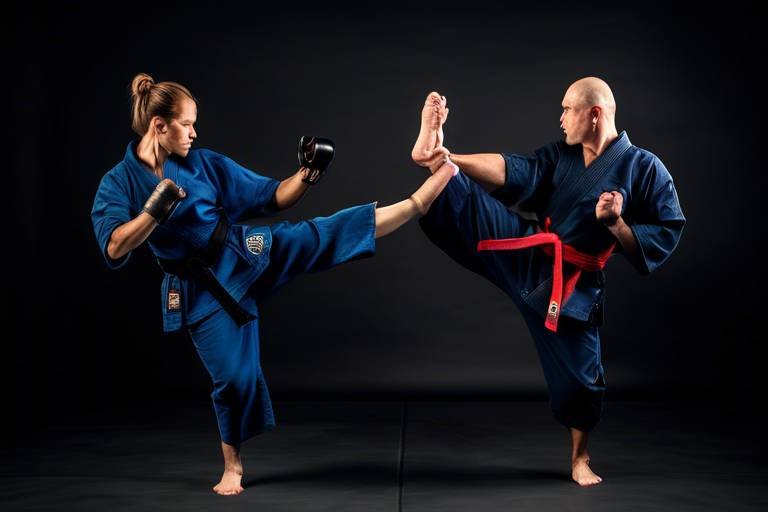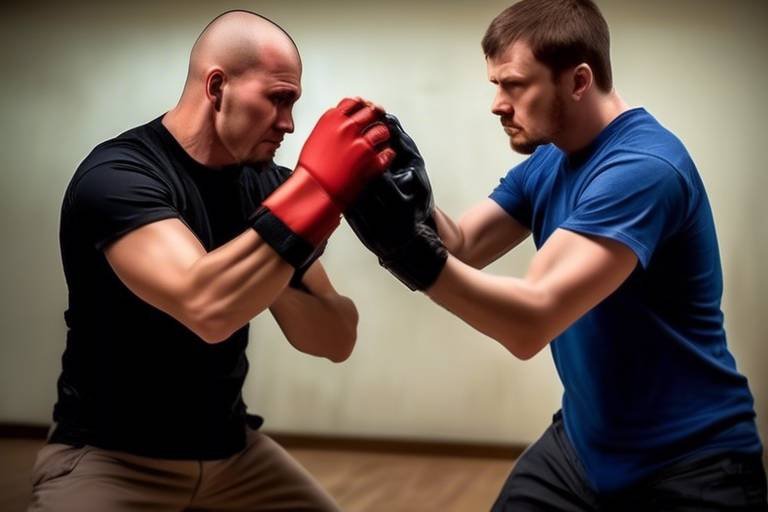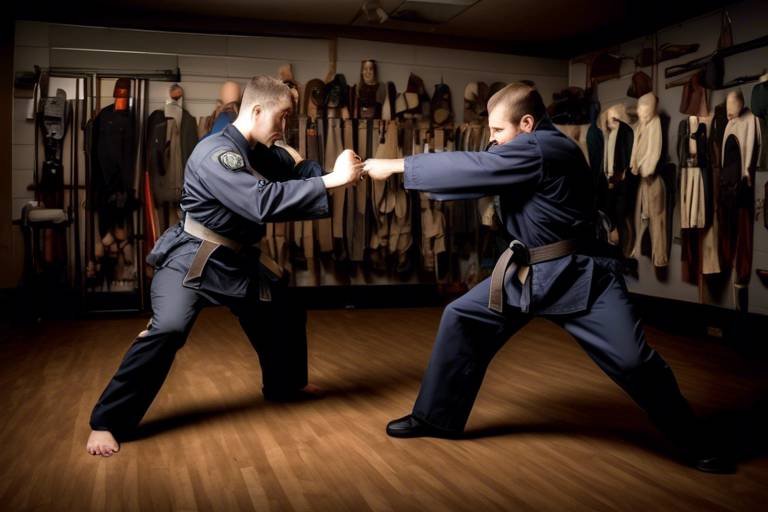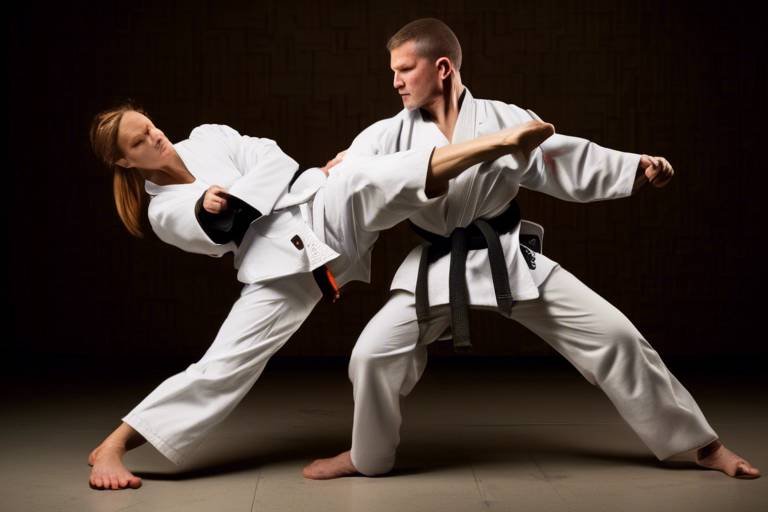Three Essential Strikes For Any Self-Defense Situation
In today's unpredictable world, personal safety is a growing concern for many individuals. Whether you're walking alone at night or simply want to feel more secure in your daily life, understanding the basics of self-defense can be a game-changer. This article discusses three fundamental strikes that can be effective in self-defense scenarios, emphasizing techniques that anyone can learn to enhance their personal safety and confidence. By mastering these strikes, you not only empower yourself but also gain a sense of control over your environment. So, let’s dive into the essential strikes that could make a difference in a critical moment.
Strikes are crucial in self-defense, providing a means to incapacitate an attacker quickly. Think of strikes as your first line of defense—much like a knight's sword in battle. If you can deliver a well-placed strike, you can create the opportunity to escape or gain control of the situation. Mastering striking techniques is essential for personal safety because it allows you to respond effectively when faced with aggression. It’s not about being a fighter; it’s about being prepared. Just like learning to ride a bike, once you know how to strike, it becomes second nature, giving you the confidence to handle unexpected confrontations.
Learning proper punching techniques can significantly improve your self-defense capabilities. Imagine your fists as tools—if you know how to use them correctly, they can be incredibly effective. The fundamental types of punches include jabs, crosses, and hooks. Each of these punches has its own unique application and can be executed effectively with the right form and practice. When you learn these basic punches, you equip yourself with the ability to defend against larger or stronger opponents. Let’s break down these techniques, starting with the jab.
The jab is a fast and versatile punch that can create distance or set up more powerful strikes. It’s like a quick flick of the wrist—fast, precise, and effective. Here, we discuss its mechanics and applications in self-defense. The jab can be used to gauge distance, keep an attacker at bay, or even create openings for more significant strikes. It’s essential to understand that the jab isn’t just a punch; it’s a strategic tool in your self-defense arsenal.
Proper form is vital for an effective jab. You want to ensure that your stance is solid, your hand is positioned correctly, and your body movement is fluid. Here’s a quick breakdown of the key components:
- Stance: Stand with your feet shoulder-width apart, one foot slightly forward.
- Hand Positioning: Keep your hands up, elbows in, and your fist at chin level.
- Body Movement: Rotate your shoulder as you extend your arm, ensuring your weight shifts slightly forward.
When executed correctly, the jab can be a powerful strike that not only keeps attackers at bay but also sets you up for follow-up punches.
Understanding when to use a jab can make a significant difference in a confrontation. Imagine facing an aggressive individual; instead of waiting for them to close the gap, a well-timed jab can disrupt their approach. Situations where a jab is most effective include:
- When you need to create distance.
- To distract or disorient an attacker.
- As a setup for more powerful strikes.
By recognizing these scenarios, you can use the jab to your advantage, turning the tables in your favor.
The crossover punch is a powerful technique that can deliver significant impact. Think of it as the heavyweight champion's knockout punch—when it lands, it can change the outcome of the fight. This section details how to execute this strike and its strategic advantages. The crossover punch involves a rotation of your hips and shoulders, which generates more force than a standard punch. To perform it effectively, follow these steps:
- Start with your feet shoulder-width apart.
- Shift your weight to your back foot.
- As you throw the punch, rotate your hips and shoulders forward.
With practice, the crossover punch can become a devastating weapon in your self-defense toolkit.
Elbow strikes are highly effective in close-range situations. When you find yourself in a tight spot, your elbows can become your best friends. These strikes are powerful and can be delivered quickly, making them ideal for self-defense. This section delves into the mechanics and benefits of using elbow strikes in self-defense, emphasizing their effectiveness when you’re too close for a full punch.
Different elbow strikes can be utilized depending on the situation. Here are a few types you might consider:
- Horizontal Elbow Strike: Great for close-range attacks, aimed at the side of the opponent's head.
- Diagonal Elbow Strike: Effective for striking downwards, targeting the chin or face.
- Back Elbow Strike: Useful when you need to defend against an attack from behind.
Each of these strikes can be adapted to various situations, making them versatile tools in your self-defense strategy.
Elbow strikes can serve both defensive and offensive purposes. When you're in a defensive stance, a quick elbow strike can create the space you need to escape. Conversely, when you’re on the offensive, these strikes can be devastating and lead to a quick resolution of the confrontation. Here’s how to incorporate them into your self-defense strategy effectively:
- Practice your elbow strikes regularly to build muscle memory.
- Incorporate them into your sparring sessions to understand their timing.
- Always be aware of your surroundings to utilize them effectively.
By mastering elbow strikes, you can enhance your self-defense capabilities significantly, ensuring that you’re prepared for any situation.
Q: Do I need any special training to learn these strikes?
A: While formal training can be beneficial, many of these techniques can be learned through practice and self-study. Consider joining a self-defense class for hands-on experience.
Q: Are these strikes effective against larger opponents?
A: Yes! The key to effective self-defense is technique and timing, not just strength. Properly executed strikes can give you the upper hand, regardless of size.
Q: How often should I practice these techniques?
A: Regular practice is essential. Aim for at least a few times a week to build muscle memory and confidence in your abilities.

Understanding the Importance of Strikes
When it comes to self-defense, understanding the significance of strikes is absolutely crucial. Strikes are not just about throwing punches; they are about empowerment and the ability to protect oneself from potential harm. In a world where personal safety can sometimes feel compromised, knowing how to effectively incapacitate an attacker can be a game-changer. Imagine being in a situation where your instincts kick in, and you can respond with confidence rather than fear. This is where mastering striking techniques comes into play.
Strikes serve as your first line of defense. They can create distance between you and an assailant, giving you precious moments to escape or prepare for further action. Think of strikes as your safety net; they provide a means to protect yourself without needing to engage in a prolonged confrontation. In many cases, a quick, effective strike can deter an attacker, leading them to rethink their decision to confront you. It's about using your body as a tool to assert your safety.
Moreover, the psychological aspect of striking cannot be overlooked. When you know you have the ability to defend yourself, it boosts your confidence tremendously. This newfound confidence can alter how you carry yourself in public, making you less of a target. It's like walking into a room with your head held high, knowing you can handle whatever comes your way. In self-defense, this mental readiness is just as important as the physical techniques you learn.
To put this into perspective, consider the following scenarios where striking can be essential:
- In a crowded area where an attacker might try to grab you from behind.
- During a sudden confrontation where you need to create space to escape.
- In close-quarter situations where other defensive moves may not be feasible.
In each of these scenarios, having a solid grasp of striking techniques can make all the difference. Not only does it give you the means to defend yourself, but it also instills a sense of security that is invaluable. Remember, the goal of self-defense is not to become a fighter, but to become a survivor. Understanding the importance of strikes is the first step in that journey.

Basic Punch Techniques
When it comes to self-defense, mastering can make a world of difference. Imagine being in a situation where you need to protect yourself; the ability to throw a punch effectively can not only help you escape but also boost your confidence. Punching is not just about brute strength; it's about technique, timing, and precision. In this section, we'll dive deep into the fundamental types of punches, how to execute them effectively, and the nuances that can turn a simple punch into a powerful self-defense tool.
The most common punches you'll want to familiarize yourself with are the jab, the cross, and the hook. Each of these punches has its own unique mechanics and applications, making them vital components of your self-defense arsenal. Let's break them down:
| Punch Type | Description | Key Uses |
|---|---|---|
| Jab | A quick, straight punch thrown with the lead hand. | Creating distance, setting up combinations. |
| Cross | A powerful straight punch thrown with the rear hand. | Delivering significant impact, countering attacks. |
| Hook | A punch that comes in from the side, targeting the head or body. | Breaking through defenses, targeting vulnerable areas. |
Now that we've outlined the basic types, let’s focus on the jab in more detail. The jab is often referred to as the "quick strike" for a reason. It’s not just about speed; it’s about using your body mechanics to deliver a punch that can keep an attacker at bay. Proper form is crucial: you want to maintain a solid stance, keep your hands up, and ensure that your elbow is aligned with your wrist as you extend your arm.
But when should you use a jab? Picture this: you're cornered, and your attacker is advancing. A well-timed jab can create just enough distance to give you a split-second advantage, allowing you to escape or prepare for a more powerful strike. It’s all about using your environment and your body effectively.
Next up is the crossover punch. This punch is all about adding power to your strikes. It involves pivoting your body and transferring weight from your back foot to your front foot, which generates momentum. The crossover punch is especially effective when you’re looking to deliver a knockout blow. Think of it as a baseball swing—you're not just using your arm; you're engaging your entire body to maximize impact.
Incorporating these punches into your self-defense strategy can be a game-changer. However, remember that practice is key. Whether it's shadow boxing or working with a partner, repetition will help you internalize these techniques. So, are you ready to throw some punches and enhance your self-defense skills?
- What is the most effective punch for self-defense? The jab is often considered the most effective punch for self-defense due to its speed and ability to create distance.
- How can I improve my punching technique? Regular practice, focusing on form, and possibly working with a coach can significantly enhance your punching technique.
- Are there any risks associated with punching in self-defense? Yes, improper technique can lead to injury. It's essential to learn the right form to minimize risks.

Jab: The Quick Strike
The jab is often referred to as the workhorse of striking techniques. It’s quick, versatile, and can be a game-changer in self-defense situations. Imagine being in a confrontation where every second counts; having a reliable jab can create the necessary distance between you and an attacker, buying you precious moments to escape or follow up with a stronger strike. But what exactly makes the jab so effective? Let’s break it down.
First and foremost, the jab is all about speed and precision. Unlike more powerful punches that require winding up, the jab is executed with minimal movement, allowing for rapid deployment. This makes it particularly useful in situations where you need to react quickly. The mechanics of a jab involve extending your lead hand straight out while keeping your elbow down, ensuring that your shoulder moves forward to generate power without compromising your balance. It’s like the flick of a wrist—quick and unexpected.
Now, let’s talk about the situational use of the jab. It’s not just a random punch; it serves multiple purposes:
- Creating Distance: If an assailant is too close for comfort, a well-timed jab can push them back, giving you room to maneuver.
- Setting Up Power Shots: A jab can distract your opponent and set them up for a more powerful strike, like a crossover punch or an elbow.
- Gauge Reaction: Using a jab can help you assess your attacker’s movements and reactions, providing valuable information on how to proceed.
In terms of form, a proper jab requires a solid stance. Your feet should be shoulder-width apart, with your dominant foot slightly behind the other. This stance not only provides stability but also enables you to pivot your body to add power to your jab. Make sure your hand is held up near your chin when not striking, ready to protect your face. Remember, the goal is to keep your guard up while delivering the jab, so you’re prepared for any counterattacks.
Lastly, let’s touch on the importance of practice. Like any skill, mastering the jab takes time and repetition. Regularly practicing your jab not only improves your technique but also builds muscle memory, making it second nature when you need it most. Consider shadow boxing or hitting a speed bag to refine your jab. The more you train, the more confident you’ll feel when the moment arises.

Form and Technique
When it comes to delivering an effective jab, are your best friends. Think of your body as a finely tuned instrument; every part needs to work in harmony to produce a powerful note. First and foremost, your stance is crucial. Stand with your feet shoulder-width apart, with your dominant foot slightly back. This not only provides you with better balance but also allows for a quick pivot if you need to move. Imagine being a coiled spring, ready to unleash your energy at a moment's notice.
Next, let’s talk about hand positioning. Your hands should be up, protecting your face, with your elbows tucked in. This is your guard, your shield against incoming strikes. When you throw the jab, it’s essential to keep your elbow down and your wrist straight. This alignment helps prevent injuries and maximizes the force you can generate. Picture your arm as a whip; if you crack it just right, the tip will deliver a powerful strike, but if your wrist is bent, you lose that energy.
Now, let’s dive into the mechanics of the jab itself. As you extend your arm, rotate your shoulder forward and pivot your back foot. This motion is akin to a baseball pitcher winding up before throwing a fastball. The power comes not just from your arm but from your entire body working together. As you strike, aim for your target with precision; it could be the attacker’s face or an area that can create enough distraction for you to escape. Remember, the goal of a jab is not just to hit but to create space and opportunity.
Finally, practice is the key to mastering this technique. Shadowboxing can be a great way to refine your form without the pressure of a real confrontation. Focus on your stance, hand positioning, and the fluidity of your movements. You can also utilize a mirror to check your form or even practice with a partner. The more you practice, the more natural it will feel, and soon enough, your jab will become a reliable tool in your self-defense arsenal.
In summary, mastering the jab involves:
- Proper Stance: Feet shoulder-width apart, dominant foot slightly back.
- Hand Positioning: Hands up for protection, elbows tucked in.
- Body Mechanics: Utilize shoulder rotation and foot pivot for power.
- Practice: Regular drills to enhance muscle memory and confidence.

Situational Use
Understanding when to deploy a jab can be the difference between escaping a dangerous situation and becoming overwhelmed. The jab isn't just a quick punch; it's a tactical tool that can be used effectively in various scenarios. Imagine you're walking down a dimly lit street, and you notice someone following you. Instead of panicking, you can use a jab to create distance and assert your space. This fast strike can catch an attacker off guard and give you a moment to escape.
Another situation where the jab shines is during a confrontation where verbal de-escalation fails. If an aggressor is advancing towards you, throwing a jab can serve as a warning shot. It signals that you’re not an easy target and that you’re prepared to defend yourself. In this context, the jab acts not only as a physical strike but also as a psychological deterrent. The aggressor might reconsider their intentions if they see you ready to fight back.
Furthermore, the jab can also be used in conjunction with other techniques. For example, after delivering a jab, you can follow up with a more powerful crossover punch or even a kick. This combination can overwhelm an attacker, making it harder for them to recover and retaliate. Remember, the key to effective self-defense is not just the strike itself, but how you use it within the flow of a confrontation.
Here are some scenarios where the jab is particularly effective:
- Creating Distance: Use the jab to keep an attacker at bay.
- Setting Up Combinations: Follow the jab with a more powerful strike.
- Distraction: Use the jab to divert attention while preparing for a more decisive move.
In summary, the jab is more than just a quick punch; it's a versatile strike that can be adapted to various self-defense situations. By mastering its use, you not only enhance your personal safety but also build confidence in your ability to handle confrontations effectively.

Crossover Punch: Adding Power
The crossover punch is often regarded as one of the most powerful strikes in a self-defense arsenal. Imagine a heavyweight boxer winding up for a knockout; that’s the kind of force we’re talking about! This punch not only delivers significant impact but also allows you to leverage your body weight effectively. When executed correctly, the crossover punch can incapacitate an attacker, giving you the crucial seconds you need to escape or gain control of the situation.
So, how do you master this powerful strike? First, it’s essential to understand the mechanics behind it. The crossover punch typically involves a strong pivot of your back foot, allowing your hips and shoulders to rotate forward as you throw the punch. This motion is akin to a coiled spring releasing energy; the more you practice, the more explosive your punch will become. Here’s a quick breakdown of the key components:
| Component | Description |
|---|---|
| Stance | Start in a balanced fighting stance, with your feet shoulder-width apart. |
| Pivot | Rotate your back foot to generate power from your legs. |
| Hip Rotation | Engage your hips to transfer energy into the punch. |
| Follow Through | Extend your arm fully, aiming for the target while maintaining balance. |
Now, let’s talk about when to use this strike effectively. The crossover punch is particularly useful in situations where you need to respond quickly to an immediate threat. For example, if an attacker closes in on you, a well-timed crossover punch can create the distance you need to escape. It’s not just about brute strength; timing and precision are equally important. Think of it as a game of chess—anticipating your opponent's next move can give you the upper hand.
Moreover, the crossover punch can be combined with other techniques for maximum effectiveness. For instance, following up with a jab after landing a crossover can keep your attacker off balance, making it harder for them to counterattack. This combination is like a one-two punch in boxing, designed to overwhelm your opponent and create openings for escape.
In conclusion, mastering the crossover punch can significantly enhance your self-defense capabilities. It’s not just about throwing a punch; it’s about understanding the mechanics, timing, and strategic applications of this powerful strike. By incorporating the crossover punch into your self-defense repertoire, you’ll not only boost your confidence but also increase your chances of effectively handling a threatening situation.
- What is the best way to practice the crossover punch? Start slow, focusing on form and technique. Use a heavy bag or shadow boxing to build muscle memory.
- Can anyone learn to throw a crossover punch effectively? Absolutely! With practice and proper guidance, anyone can learn this technique.
- When should I use a crossover punch in a self-defense situation? Use it when you need to create distance or when your attacker is within striking range.
- Are there any risks associated with using the crossover punch? Like any striking technique, improper execution can lead to injury. Always practice safely and consider training with a professional.

Elbow Strikes: Close-Quarter Combat
When it comes to self-defense, close-quarters combat can be one of the most challenging scenarios to navigate. This is where elbow strikes come into play, providing a powerful and effective means of defense when you find yourself in tight spaces. Imagine being cornered in a narrow hallway or a crowded bus; your options for striking might be limited, but your elbows can deliver devastating blows even in the most confined situations. Elbow strikes are not just about brute force; they are about precision and timing, allowing you to utilize your body's natural weapons to incapacitate an attacker swiftly.
One of the key advantages of elbow strikes is their versatility. They can be executed from various angles and positions, making them particularly useful in a self-defense scenario. Whether you’re standing, kneeling, or even on the ground, your elbows can target an assailant's vulnerable areas, such as the head, face, or ribs. The close proximity required for these strikes means that you don’t need to rely on distance or momentum, which can be a game-changer when you’re caught off guard.
Moreover, elbow strikes are often more powerful than punches, as they utilize the weight of your entire body behind the strike. When you throw an elbow, you engage your core and hips, maximizing the force delivered with minimal movement. This makes elbow strikes incredibly efficient, allowing even those without extensive training to harness their potential. In fact, many martial arts incorporate elbow strikes into their techniques, recognizing their effectiveness in real-life confrontations.
There are several types of elbow strikes, each suited for different situations. Here’s a quick overview:
- Horizontal Elbow Strike: This strike is delivered by swinging the elbow horizontally across the body, aimed at the opponent's head or torso.
- Diagonal Elbow Strike: This involves an upward or downward angle, targeting the chin or jaw, perfect for catching an opponent off guard.
- Back Elbow Strike: Used when an attacker is directly behind you, this strike can be devastating as it utilizes the element of surprise.
Understanding these different types of elbow strikes can help you choose the right technique based on your situation. For instance, if an attacker is coming at you head-on, a horizontal elbow strike could create the space you need to escape. Conversely, if you're grappling with someone, a back elbow strike can surprise them and give you the upper hand.
Elbow strikes can serve both defensive and offensive purposes, making them an integral part of your self-defense strategy. For example, when you anticipate an incoming punch, a well-timed elbow strike can deflect the attack while simultaneously delivering a counter-strike. This dual-action not only protects you but also creates an opening for you to escape or follow up with additional strikes.
In addition to their practical applications, practicing elbow strikes can also boost your confidence. Knowing that you have effective techniques at your disposal can make a significant difference in your mindset during a confrontation. Remember, self-defense is not just about physical techniques; it’s also about mental preparedness. The more you train, the more instinctive these movements will become, giving you the confidence to react swiftly and decisively when it matters most.
In conclusion, mastering elbow strikes is essential for anyone looking to enhance their self-defense skills. Their effectiveness in close-quarters combat, combined with their versatility and power, makes them invaluable tools for personal safety. So, whether you’re practicing in a dojo or just looking to feel more secure in your daily life, incorporating elbow strikes into your repertoire can be a game-changer.
Q: Are elbow strikes effective for self-defense?
A: Yes, elbow strikes are highly effective in self-defense, especially in close-quarters situations where other strikes may be difficult to execute.
Q: Do I need special training to use elbow strikes?
A: While training can enhance your technique, the basic mechanics of elbow strikes can be learned by anyone. Practicing regularly will help you become more proficient.
Q: Can elbow strikes be used in sports?
A: Yes, elbow strikes are used in various martial arts and combat sports, such as Muay Thai and MMA, showcasing their effectiveness in both competition and self-defense.

Types of Elbow Strikes
When it comes to self-defense, understanding the different types of elbow strikes can significantly enhance your ability to protect yourself in close-quarters situations. Elbow strikes are not just about brute force; they require technique, precision, and an understanding of your opponent's position. Imagine being in a tight space, where swinging a full punch is impossible. This is where elbow strikes shine—they are powerful, compact, and can be delivered quickly.
There are several types of elbow strikes you can master, each with its unique application and effectiveness. Here are some of the most common types:
- Horizontal Elbow Strike: This strike is delivered horizontally across your body, targeting the opponent's face or head. It's particularly effective when you're close enough to your attacker, and it can cause significant damage.
- Diagonal Elbow Strike: A diagonal elbow strike travels at an angle, usually aimed at the opponent’s temple or jaw. This strike is useful when you're in a clinch or grappling situation.
- Uppercut Elbow Strike: This upward motion strike targets the chin or jaw, often catching the opponent off guard. It’s especially useful in a surprise attack when you’re in close proximity.
- Back Elbow Strike: As the name suggests, this strike is delivered by swinging your elbow backward, making it effective for escaping a hold or countering an attack from behind.
Each type of elbow strike can be adapted to various self-defense scenarios. For instance, if you're grappling with an attacker, the horizontal elbow strike can create the necessary space for you to escape. On the other hand, if you're surprised from behind, the back elbow strike can quickly turn the tables on your attacker.
Moreover, the effectiveness of these strikes can be amplified by combining them with other techniques. For example, following a horizontal elbow strike with a jab can keep your opponent off balance, allowing you to create more distance or set up for a more powerful attack. The beauty of elbow strikes lies in their versatility; they can be used defensively to block an incoming attack or offensively to incapacitate an assailant.
In conclusion, mastering the different types of elbow strikes can provide you with a solid foundation for self-defense. They are not only effective but can also be easily integrated into your overall strategy. Remember, the key to self-defense is not just about knowing how to strike but also understanding when and how to apply these techniques in real-life situations.
1. Are elbow strikes legal in self-defense situations?
Yes, elbow strikes can be legal in self-defense situations, but it’s crucial to understand the laws in your area regarding self-defense. Always use the minimum force necessary to protect yourself.
2. Can anyone learn to perform elbow strikes effectively?
Absolutely! With practice and proper instruction, anyone can learn to perform elbow strikes effectively. Consider enrolling in a self-defense class or martial arts training to refine your techniques.
3. How do I improve my elbow strike technique?
Improving your elbow strike technique involves practice, focusing on form, and understanding your body mechanics. Regular training and drills can enhance your speed and power.
4. Are elbow strikes effective against larger opponents?
Yes, elbow strikes can be very effective against larger opponents due to their close-range nature and the ability to generate significant power from a compact movement. The key is to strike quickly and accurately.

Defensive and Offensive Use
Elbow strikes are incredibly versatile and can be utilized in both defensive and offensive scenarios, making them a crucial addition to your self-defense arsenal. When we think of self-defense, it's easy to imagine powerful punches or kicks, but the elbow strike often gets overlooked. However, it can be a game-changer, especially in close-quarters situations where space is limited. Imagine being in a tight spot, perhaps in a crowded area or even inside a vehicle; this is where elbow strikes shine.
From a defensive standpoint, elbow strikes can be used to create space between you and an attacker. For instance, if someone is trying to grab you or push you against a wall, a well-placed elbow strike to their torso or face can disrupt their momentum and give you the opportunity to escape. This is especially effective because the elbow is a hard and sharp part of the body, capable of delivering significant damage with minimal movement. It’s like using a hammer in a toolbox; sometimes, a simple tool can do the job better than the more complex ones.
On the offensive side, elbow strikes can be devastating. They can be used to target vulnerable areas such as the nose, jaw, or temple, causing disorientation and pain to the attacker. The beauty of elbow strikes lies in their unpredictability. You can throw an elbow strike from various angles, making it difficult for an opponent to anticipate your moves. For example, you could throw a quick jab to distract your opponent and follow it up with a swift elbow strike to the side of their head. This combination can catch them off guard, creating an opening for further action.
To further understand the application of elbow strikes in self-defense, consider the following scenarios:
- Defensive Scenario: An attacker closes in on you, attempting to grapple. A quick elbow strike to the attacker’s face can create the necessary distance, allowing you to escape.
- Offensive Scenario: You find yourself in a confrontation where you need to assert control. A series of elbow strikes to the opponent’s head can incapacitate them, giving you the upper hand.
Moreover, when practicing elbow strikes, it’s essential to focus on the proper technique. Ensure that your elbow is aligned with your shoulder for maximum impact. This alignment not only increases the force of your strike but also helps prevent injury to yourself. Think of it as the difference between a well-aimed dart and a thrown ball; precision matters!
In conclusion, whether used defensively to fend off an attacker or offensively to take control of a situation, elbow strikes are a powerful tool in self-defense. By incorporating them into your training, you can enhance your ability to respond effectively in various scenarios, ensuring that you are prepared for whatever comes your way.
Q: Are elbow strikes effective for self-defense?
A: Yes, elbow strikes are highly effective in self-defense due to their power and versatility, especially in close-quarter situations.
Q: How can I practice elbow strikes safely?
A: Practicing with a partner using pads or a heavy bag can help you develop technique and power without risking injury.
Q: Can elbow strikes be used in combination with other techniques?
A: Absolutely! Elbow strikes can be effectively combined with punches, kicks, and other strikes to create a powerful self-defense strategy.
Frequently Asked Questions
- Why is mastering strikes important for self-defense?
Mastering strikes is essential because they provide a quick and effective way to incapacitate an attacker. In a self-defense situation, having the ability to deliver a powerful strike can mean the difference between escaping safely or facing serious harm.
- What are the basic types of punches I should learn?
The fundamental punches to learn include the jab, crossover punch, and hook. Each of these punches serves a unique purpose in self-defense, helping you create distance, deliver power, or target vulnerable areas of an attacker.
- When should I use a jab in a self-defense situation?
The jab is most effective when you need to create space or distract your attacker. It's a fast strike that can help you set up for more powerful punches or give you the time you need to escape a dangerous situation.
- How do I execute a proper crossover punch?
To execute a crossover punch, start with a solid stance, rotate your hips, and follow through with your arm to deliver maximum impact. It’s important to practice this technique to ensure you can deliver it quickly and effectively when needed.
- What are elbow strikes and when should I use them?
Elbow strikes are powerful close-range techniques that can be used when an attacker is very close to you. They are effective for both offensive and defensive maneuvers, allowing you to strike while also protecting yourself.
- Can elbow strikes be used in both defensive and offensive situations?
Yes! Elbow strikes can be utilized defensively to fend off an attacker or offensively to deliver a strong blow. Their versatility makes them a valuable tool in any self-defense strategy.
- How can I practice these striking techniques safely?
Practicing with a partner or a punching bag is a great way to refine your techniques. Always use proper protective gear and start slowly to ensure you’re executing the techniques correctly before increasing speed and power.

